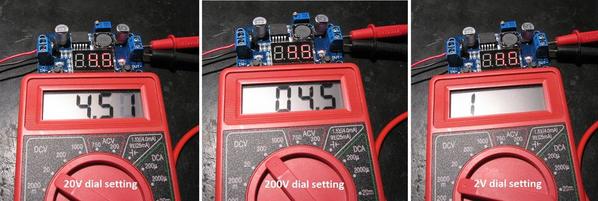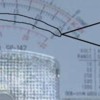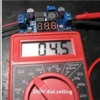Got your email. I'll answer your question here about the dial setting of the HF meter since we may need to refer to it again.

So here's the HF meter measuring the DC output of an eBay voltage regulator module that has been set to 4.5V. In other threads, I suggest these modules as an inexpensive way to generate regulated DC voltage for Menards and Lemax buildings, Miller signs, etc. In this case the module even has its own digital meter showing it has been set to 4.5V DC.
Anyway, with the dial setting at 20V (left) the HF meter reads 4.51. This would indeed be the setting to use for the Menards adapter issue at hand. If you go to the 200V (middle) setting, note how the decimal point automatically moves for you...no need to mentally adjust the factor. But note how you lose resolution in the measurement. This is why you want to use the lowest dial setting that still covers the range of voltages you expect to measure. This loss of resolution is like your analog meter's needle barely moving if the setting is too large; you can see the needle move but difficult to resolve the value.
If you go to the 2V (right) setting, the 4.5V overwhelms the meter. In this case the meter display just shows a "1". Other meters might display "OF" (OverFlow), or flash, or whatever. On an analog meter this is where the needle is pinned over to the right side.
More expensive meters have so-called "auto-ranging" capability which automatically chooses the dial setting to maximize the resolution.
As to the wire issue, yes, it's all about formulas. Look it up in any wire-table and 20 gauge wire has a resistance of about 1 Ohm for 100 feet. If you are running a 15 ft cable pair or 30 ft of wire that is a resistance of 0.3 Ohms. Then you use the Ohm's Law which tells you how much Voltage you lose. Voltage = Current x Resistance. You need to know the Current (Amps) which, as I've previously lamented, Menards does not seem to publish. But a reasonable guess is to note that their 1-building adapter is rated at 500mA (or 0.5 Amps) and their 3-building adapter is rated at 2000mA (or 2 Amps). So let's just go with 0.5 Amps per building. That means your 15 ft cable will drop/lower the voltage by 0.5 Amps x 0.3 Ohms = 0.15 Volts. So if the voltage "started" at 4.5V DC, introducing the extra 15 ft of 20 gauge wire means the building only get 4.35 Volts. My opinion is you shouldn't see a material difference in brightness or behavior for that small a change.
Note that if you do make such an extension cable you will only see that voltage drop when the current is flowing into the building. If you measure the voltage at the extended plug (not plugged into the building) you will measure the original voltage. In other words the current is 0 Amps so the voltage drop from the 0.3 Ohm extension cable is 0 Amps x 0.3 Ohms = 0 Volts.
Finally, the HF meter also has the ability to measure DC current. I believe we concluded that your existing analog meter only goes up to 250mA (0.25 Amps) which presumably is not enough to measure the building current. When you get the meter, we can get into the specifics of how to measure building current with the HF meter if you are so inclined.








